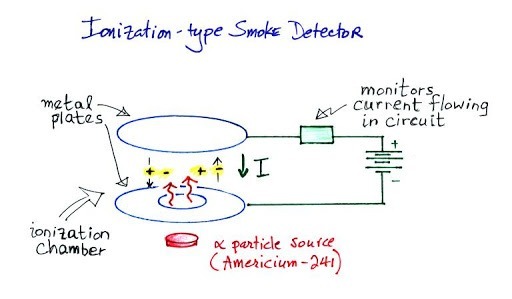Smoke detectors are useful when it comes to saving lives.
They occupy little space, are pocket-friendly yet are extremely effective at detecting fire hazards.
These life-saving devices need to be installed and placed correctly for safety.
There are two types of smoke alarms, which are available readily.
I will discuss the basic working idea behind both these types of smoke detectors.
The workings of smoke detector alarms: Explained!
The two types of smoke detectors used are ionization and photoelectric detectors.
Components such as the power supply, a sensor, and an alarm or a horn are common for both these detectors.
How do ionization smoke detectors work?
- It consists of an ionization chamber open to the air.
- It has wires extending from the positive and negative ends of the battery in the detector.
- These wires are attached to separate electrodes.
- The ions come from a chemical element called americium, which is present inside the chamber.
- These electrodes complete a circuit when charged air particles move between two charged plates.
- In the event of a fire, the smoke particles get inside the detector.
- This leads to the clogging up of the ionization chamber.
- The circuit is broken.
- The alarm starts to ring.
That is the basic workings of an ionization smoke detector.
Now, let us see how photoelectric smoke detectors work?
- An LED casts light unlocked towards the other end of the enclosure.
- There is a photoelectric detector at the other end.
- It detects the light coming, which tells the system that the circuit is complete.
- However, when smoke enters inside, the smoke obstructs the light.
- The redirected light falls into the photocell, which is present inside the chamber.
- When this photocell detects light, it rings the alarm.
Here's a diagram of how a photoelectric smoke alarm works.

The basic idea of operation in both these smoke detectors is more or less the same.
With the emergence of new technologies, there are smoke detectors that make use of both of these types of detectors.
These are commonly known as integrated smoke detectors. These are even more reliable and accurate when it comes to detecting fire hazards.
The photoelectric smoke alarms are capable of detecting smoke coming from smoldering fires.
The photoelectric smoke detectors are more sensitive making them the primary choice for residential needs.
They can also lead to false alarms in some cases.
On the other hand, ionization detectors are better at detecting flaming fires.
Both of these types of smoke alarms are responsive to different types of fires.
Nonetheless, these smoke alarms are both crucial to save houses from fires.
They are budget-friendly too, so, installing both of these types or the integrated types of smoke detector alarms is a good idea.
It is important to keep checking if their batteries are working or the wires are connected.
Finally, make sure your smoke detector isn't recalled.
Owais Shah From Workery Champ says, there are millions of products recalled each year and if you are using a recalled smoke detector, you are putting yourself and your family in danger.

